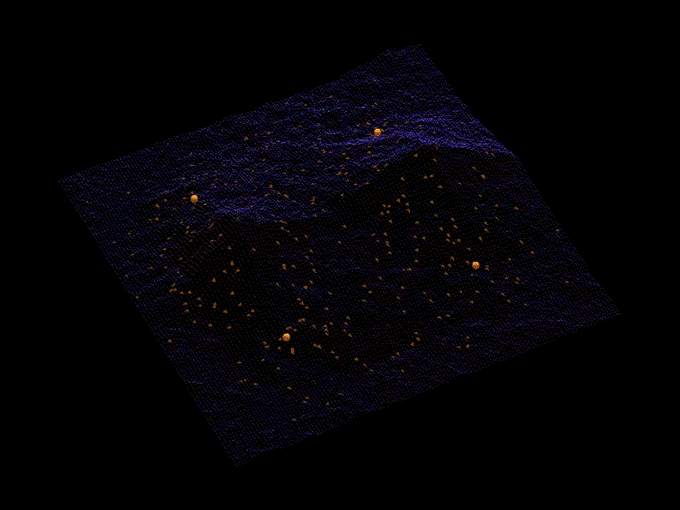Self-organizing Computation
Program for Simulating the Origins of Urban Form \ From Prediction to Synthesis
This project explores a generative aspect of agent-based models on an urban scale and proposes a computational method that simulates growth processes of settlement patterns. There is an earlier work that introduced methods to produce spatial patterns using the behavior of spatial agents. Helbing et al. (2001) have done computational simulations using their “active walker model” and simulated trail formations observed within a human trail system. Their agents use a marking behavior that leaves modifications of the ground that make it more comfortable to walk on. This implementation is similar to the formation of trail systems by certain ant species using chemotaxis, and an algorithmic implementation of chemotaxis was also introduced by Dorigo (1992). In architectural research, Schaur (1991) investigated empirical precedents of a human trail system, and these precedents indicate that many computational simulation results are able to obtain characteristics of pattern formations in a human trail system.
The method uses interactions and feedback among its own components, agents, and environment, and produces new instances of the spatial layout of paths and buildings from primary inputs of a given landform and environmental conditions. The proposed system is a computer program written in C# and is applicable to any terrain found in Google Earth by exporting geographical data. The system’s three primary components are terrain, agents, and buildings. The system assumes that the development starts from the unoccupied empty terrain. The primary behavioral characteristics of agents include physical mobility such as hill-climbing ability, their attraction toward environmental conditions, their selection of paths based on local traffic density, and presence or absence of global destinations. The terrain surface is subdivided into a grid of triangulated patches that can store dynamic local information about traffic intensity of agents (settlers). The buildings and streets (trails) will be gradually generated by the agents as a part of their behaviors. Agents’ behaviors are updated accordingly as new paths and buildings are generated. This co-evolutionary process between agents and environments is known to exist in many self-organizing systems.
References:
Helbing, D., Farkas, I. J., and Bolay, K. (2001). Environment and Planning B, 2001, Self-organizing pedestrian movement.
Environment and Planning B: Planning and Design, 28, 361–383.
Dorigo, M. (1992). Optimization, learning and natural algorithms, PhD thesis, Politecnico di Milan, Italy.
Schaur, E. (1991). Non-planned settlements: Characteristics features—Path system, surface subdivision, ed. F. Otto, Vol. 39
of Institute for Lightweight Structures (IL), University of Stuttgart, Germany.
Related Publications:
(Book Chapter)
Narahara, T., Computation for Humanity—Information Technology to Advance Society (1st edition). In Justyna Zander and Pieter Mosterman (Ed.), Boca Raton, Florida: CRC Press, Taylor & Francis Group, LLC., 2014. pp. 69-94. (Peer-reviewed in 2 stages)
(Chapter 6 of my thesis for more details)
Self-organizing Computation: A Framework for Generative Approaches in Architectural Design
Narahara, T., Doctor of Design thesis, Harvard, 2010















